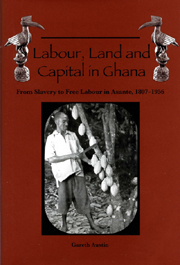Book contents
- Frontmatter
- Contents
- List of Illustrations
- List of Tables
- Preface
- Note on Names
- Maps
- Note on the Maps
- 1 Introduction
- Part I Context and Concepts
- Part II Social Relations of Production and Trade, 1807–1896: Absent and Imperfect Factor Markets
- 5 Land Tenure, 1807–1896
- 6 The Mobilization of Labour, 1807–1896
- 7 Capital and Credit, 1807–1896
- Part III Slavery as Hobson's Choice: An Analysis of the Interaction of Markets and Coercion in Asante's Era of ‘Legitimate Commerce’, 1807–1896
- Part IV The Decline of Coercion in the Factor Markets of Colonial Asante: Cocoa and the Ending of Slavery, Pawnship and Corvée, 1896–c.1950
- Part V Social Relations of Production and Trade, 1908–1956: Towards Integrated Factor Markets?
- Part VI Freedom and Forest Rent, 1908–1956
- Abbreviations Used in the Notes
- Notes
- List of References
- Index
7 - Capital and Credit, 1807–1896
from Part II - Social Relations of Production and Trade, 1807–1896: Absent and Imperfect Factor Markets
Published online by Cambridge University Press: 12 September 2012
- Frontmatter
- Contents
- List of Illustrations
- List of Tables
- Preface
- Note on Names
- Maps
- Note on the Maps
- 1 Introduction
- Part I Context and Concepts
- Part II Social Relations of Production and Trade, 1807–1896: Absent and Imperfect Factor Markets
- 5 Land Tenure, 1807–1896
- 6 The Mobilization of Labour, 1807–1896
- 7 Capital and Credit, 1807–1896
- Part III Slavery as Hobson's Choice: An Analysis of the Interaction of Markets and Coercion in Asante's Era of ‘Legitimate Commerce’, 1807–1896
- Part IV The Decline of Coercion in the Factor Markets of Colonial Asante: Cocoa and the Ending of Slavery, Pawnship and Corvée, 1896–c.1950
- Part V Social Relations of Production and Trade, 1908–1956: Towards Integrated Factor Markets?
- Part VI Freedom and Forest Rent, 1908–1956
- Abbreviations Used in the Notes
- Notes
- List of References
- Index
Summary
In the nineteenth century the Akan language distinguished between money as such (sika) and capital. The main word for capital was dwetiri, defined in Christaller's 1881 Akan dictionary as ‘a capital or stock of money to begin trade with; a fund employed in business or any undertaking’. Sika-tan meant ‘capital, principal (capital), stock.’ J. H. Nketia has noted that tan meant fruitful, so that sika-tan meant invested sum—a route which conveys the economist's understanding of capital very precisely. It is possible that Christaller, in compiling what was the first Twi dictionary, himself stretched the meanings of words to try to convey unfamiliar concepts. But his rendering of these terms appears to have been consistent with the usage of survivors from the nineteenth century interviewed by native speakers in the mid-twentieth. A case will be presented shortly in which dwetiri was used in the 1940s by an elder recalling his own experience in the late nineteenth century. It will be evident from this example that ‘any undertaking’ could include a marriage as well as a business. But then it may well be said that in this context marriage was, among other things, business.
This chapter discusses the means of raising funds for productive investment, that is, for generating future returns. Three categories of source were available: the investor's own savings, equity participation by others, and loans. As we shall see, the market's direct role was confined to providing a large proportion of the latter.
- Type
- Chapter
- Information
- Labour, Land and Capital in GhanaFrom Slavery to Free Labour in Asante, 1807–1956, pp. 135 - 152Publisher: Boydell & BrewerPrint publication year: 2005

